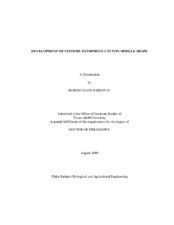| dc.contributor.advisor | Searcy, Stephen W. | |
| dc.creator | Hardin, Robert Glen | |
| dc.date.accessioned | 2011-10-21T22:02:32Z | |
| dc.date.accessioned | 2011-10-22T07:11:48Z | |
| dc.date.available | 2011-10-21T22:02:32Z | |
| dc.date.available | 2011-10-22T07:11:48Z | |
| dc.date.created | 2009-08 | |
| dc.date.issued | 2011-10-21 | |
| dc.date.submitted | August 2009 | |
| dc.identifier.uri | https://hdl.handle.net/1969.1/ETD-TAMU-2009-08-7115 | |
| dc.description.abstract | Properly constructed modules will prevent reduced lint value and increased ginning costs when significant rainfall occurs. Additionally, cotton producers often have difficulty finding adequate labor during harvest. These issues were addressed by developing a graphical operator feedback system, a biomass package measurement system, a powered tramper, and an autonomous module forming system. A system that provided feedback on the module shape by recording the position of the tramper and carriage was used to direct the operator to move cotton to appropriate locations. The system correctly predicted the height of 67% of data points. Use of the feedback system resulted in a 55% reduction in water collection area of the modules. The module builder operators indicated that the system was useful. The module builder feedback system is a simple, useful, and inexpensive tool that can have a rapid payback for producers. A powered tramper, with an auger to move cotton to the center of the module, was developed to replace the conventional tramper. The powered tramper operated automatically without affecting the operating speed or pressure of the tramper cylinder. During testing, the powered tramper was observed moving cotton to the center and crowned modules were produced. A biomass package measurement system was developed to record the height at multiple points on the top surface of modules. The system was found to produce repeatable measurements with an error of 5 cm. Data collected with this system did not indicate a difference in module shape when using the powered tramper; however, during these tests the powered tramper was turned off prematurely due to an improperly sized valve on the module builder. An automated module building system capable of both moving and tramping cotton was developed. This system utilized the feedback system sensors and photoelectric sensors to determine the location of cotton in the builder. A wireless display allowed the boll buggy operator to control the automatic system. The automatic system constructed modules with 64% less water collection area in an average time of 37.4 min. Cotton producers indicated that the system was easy to use and of significant value in reducing labor requirements. | en |
| dc.format.mimetype | application/pdf | |
| dc.language.iso | en_US | |
| dc.subject | Cotton | en |
| dc.subject | Module Builder | en |
| dc.subject | Automation | en |
| dc.subject | Instrumentation | en |
| dc.subject | Control | en |
| dc.title | Development of Systems to Improve Cotton Module Shape | en |
| dc.type | Thesis | en |
| thesis.degree.department | Biological and Agricultural Engineering | en |
| thesis.degree.discipline | Biological and Agricultural Engineering | en |
| thesis.degree.grantor | Texas A&M University | en |
| thesis.degree.name | Doctor of Philosophy | en |
| thesis.degree.level | Doctoral | en |
| dc.contributor.committeeMember | Lemon, Robert G. | |
| dc.contributor.committeeMember | Parnell, Jr., Calvin B. | |
| dc.contributor.committeeMember | Thomasson, J. A. | |
| dc.type.genre | thesis | en |
| dc.type.material | text | en |


